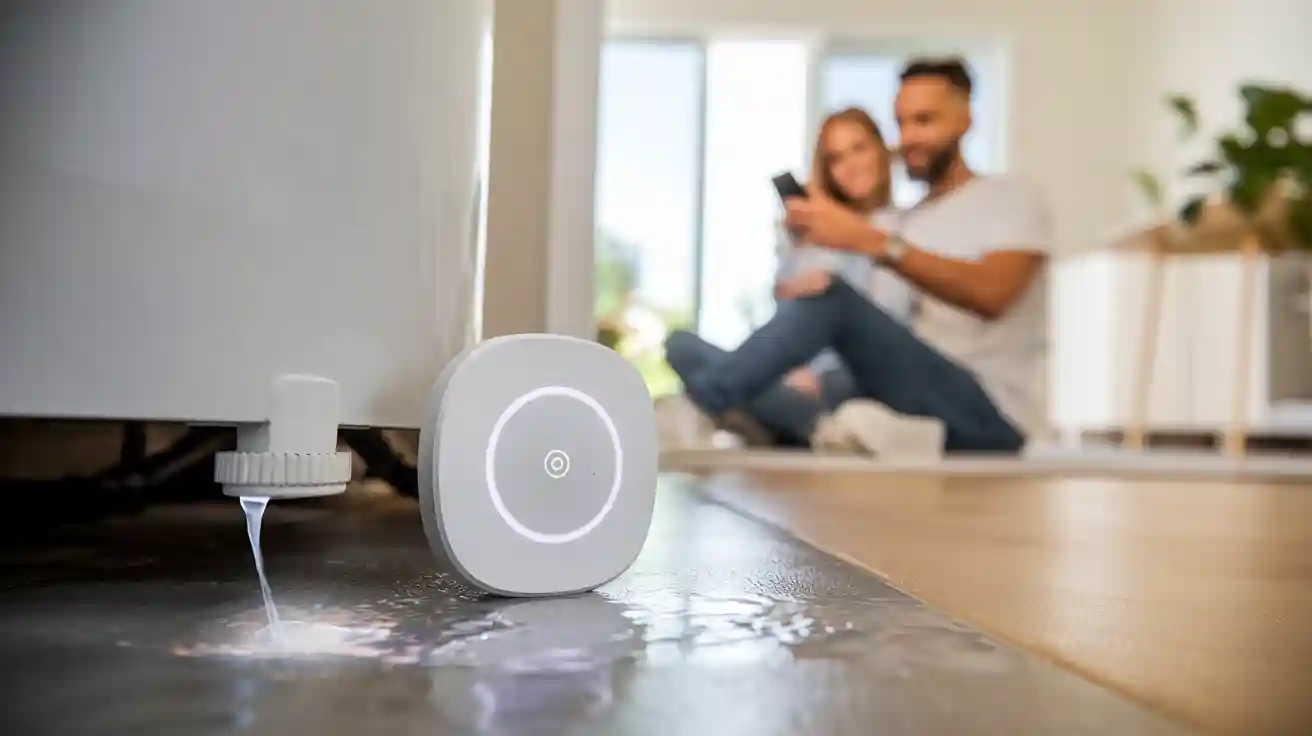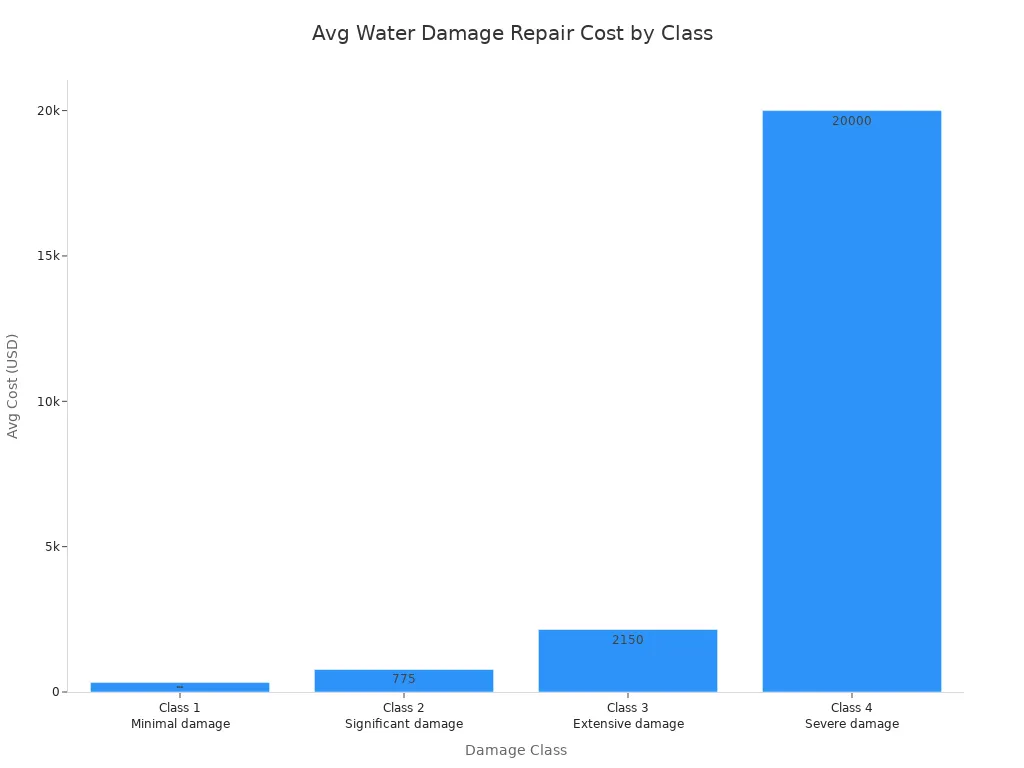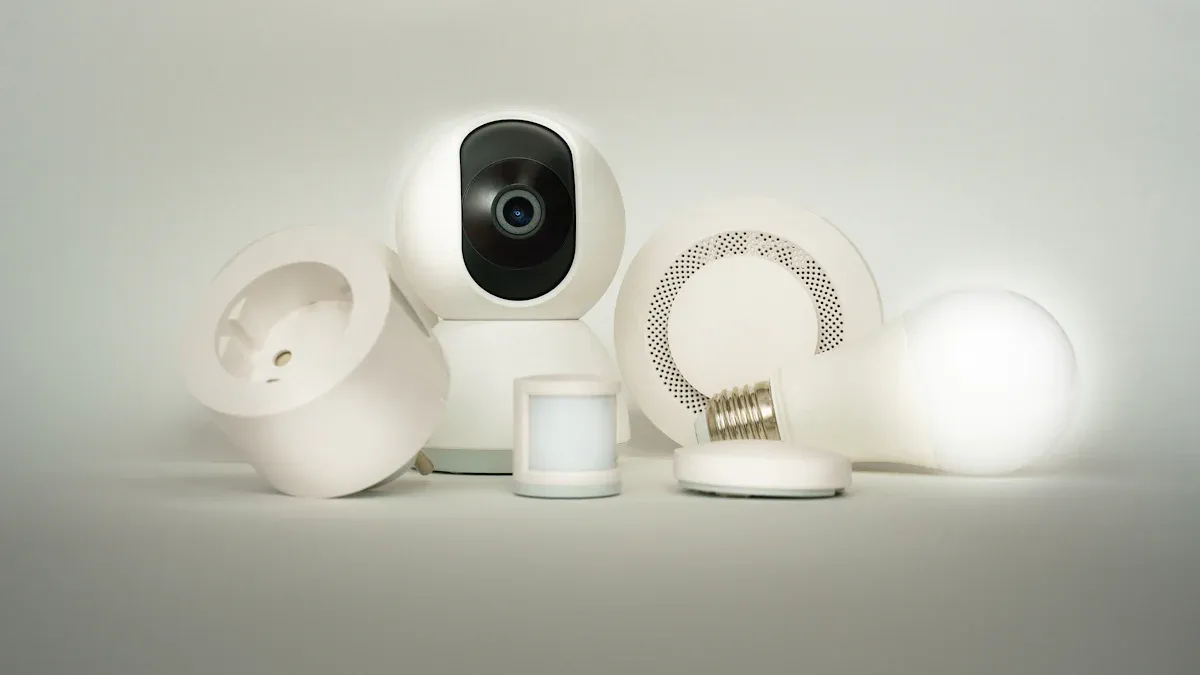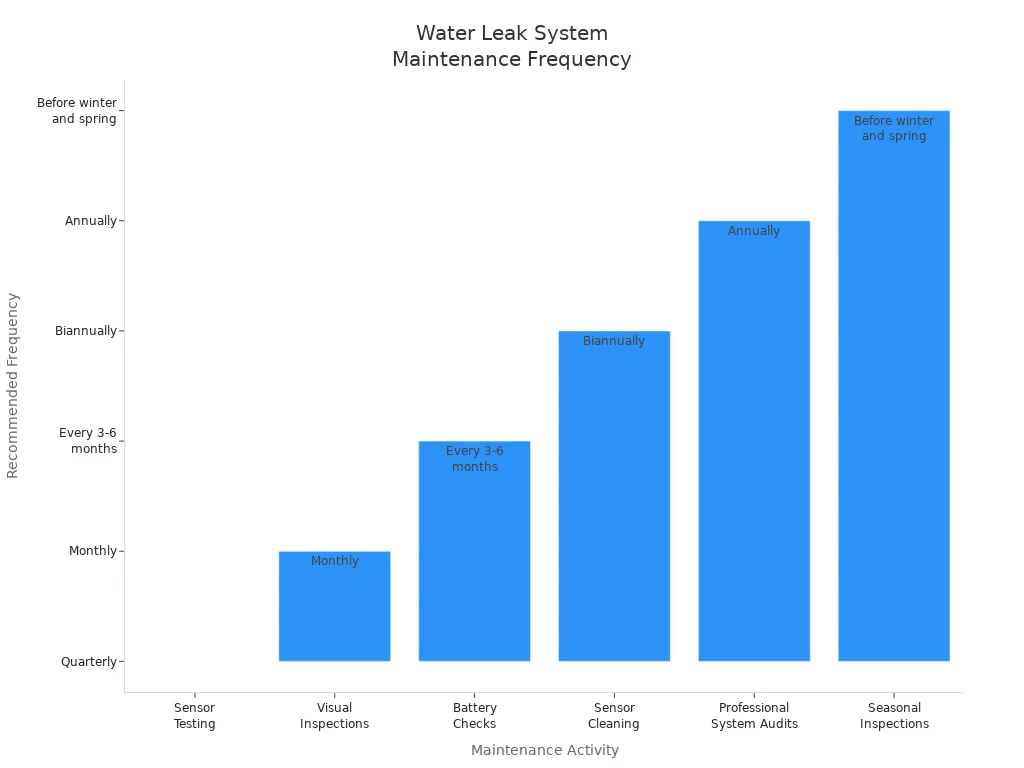How Modern Water Sensors Prevent Home Water Damage

You face a real risk from leaks in your home. Nearly 44% of U.S. homeowners have dealt with water damage in just two years. With leakage sensor water technology, you get real-time detection that helps spot a leak before it spreads. These water sensors send instant alerts, and some even shut off the water flow right away. A water leak detection system uses advanced sensor technology to help prevent water damage and wasted water. Early water leak detection means fewer repairs and more peace of mind. The table below shows how common leaks and water damage have become:
| Statistic Description | Value/Percentage |
|---|---|
| U.S. homeowners experiencing water damage in 2 years | 44% |
| Annual water damage claims (insured homes) | About 1 in 60 homes (1.6%) |
| Water lost to hidden leaks per household yearly | Nearly 10,000 gallons |
How Leakage Sensor Water Technology Prevents Water Damage
Real-Time Water Leak Detection
You want to catch a leak before it causes damage. Modern leak detection systems use advanced sensor technology to give you immediate water presence detection. These systems monitor your home’s water flow, pressure, and even acoustic signals 24/7. When a leak starts, the system detects changes in flow or pressure right away. This early water leak detection helps you stop problems before they grow.
Today’s leak detection systems use smart sensors powered by the Internet of Things (IoT) and artificial intelligence. These sensors collect real-time data and send it to the system for analysis. The system looks for patterns that signal a leak, such as sudden drops in pressure or unusual sounds in the pipes. Some systems even use satellite-based remote sensing, like synthetic aperture radar, to find underground leaks without digging up your yard. This technology allows for immediate water presence detection, even in hard-to-reach places.
Tip: Real-time leak detection systems can spot leaks inside walls or under floors, where you might not notice a problem until it’s too late.
Compared to traditional methods, which rely on manual checks, modern leak detection systems respond much faster. Acoustic sensors can pinpoint the exact location of a leak, even if it’s hidden. Infrared sensors detect temperature changes caused by water leaks, making inspections quick and non-invasive. With these advancements, you get accurate leak detection and less disruption to your home.
Instant Alerts and Notifications
When a leak happens, you need to know right away. Leak detection systems send instant alerts and notifications to your phone or smart device. These notifications let you act fast, even if you are not at home. The system detects moisture or changes in humidity and sends a notification of a leak through an app or text message.
Modern water leak detection systems use wireless communication methods like WiFi, LoRaWAN, and cellular networks. These systems provide real-time monitoring and instant alerts. You can customize notifications based on your water usage or risk areas in your home. The system streams live data, so you always know what is happening with your water.
- Instant alerts help you:
- Respond quickly to leaks, reducing water damage.
- Prevent costly repairs by stopping leaks early.
- Avoid secondary problems like mold, which can start growing within 24-48 hours after a leak.
Note: Integration with smart home devices means your leak detection system can work with other safety features, like security cameras or alarms.
Compared to old-fashioned detectors that only sound an alarm, smart leak detection systems automate the process. You get a notification wherever you are, so you never miss a leak. This fast response time can save you thousands of dollars in repairs.
Automatic Leak Detection System Shutoff
Sometimes, a leak happens when you are asleep or away from home. Automatic shutoff features in leak detection systems protect your home by stopping the water flow as soon as a leak is detected. The system uses a motorized valve that closes when the sensor finds a leak. This action prevents minor leaks from turning into major disasters.
Automatic shutoff valves monitor water flow and look for unusual patterns. When the system detects a leak, it shuts off the water supply immediately. Many systems also send a real-time alert to your phone, so you know what happened. This feature gives you peace of mind, knowing your home is protected even if you cannot respond right away.
- Benefits of automatic shutoff in leak detection systems:
- Stops water damage before it spreads.
- Reduces water waste and repair costs.
- Works with smart technology for remote monitoring and control.
- Ensures safety and reliability with professional installation.
One in fifty-five homes faces a major water leak each year, with damages averaging $8,000. Automatic shutoff valves in your leak detection system can prevent these costly disasters.
Whole-house flow-based leak detection systems offer the best protection. They monitor all water entering your home and can detect both small drips and large bursts. With IoT connectivity, backup power, and remote control, these systems keep your home safe from water damage at all times.
The True Cost of Water Damage and Undetected Leaks
Common Sources of Water Leaks in the Home
You may not always notice a leak right away, but many areas in your home are at risk. Some leaks are easy to spot, while others stay hidden for months. Here are the most common sources of water leaks you should watch for:
- Faulty faucets and toilets, such as running toilets and dripping faucets, can waste a lot of water.
- Loose or broken hose connections outside your home may cause wet spots and soil erosion.
- Cracked sinks or tubs allow water to seep into floors and walls.
- Worn out seals on appliances like dishwashers, refrigerators, and washing machines often lead to leaks.
- Clogged drain lines can cause water to back up and burst pipes.
- Corroded pipes, especially older ones, may leak or even collapse.
- Ruptured water heaters leak due to corrosion or sediment buildup.
- Invasive tree roots sometimes break underground water lines, causing leaks and yard damage.
You should also check for toilet leaks caused by faulty flappers, dripping outside faucets, and leaks behind washing machines. Even irrigation systems and refrigerator water lines can develop potential leaks. Regular plumbing leak detection helps you find these problems early.
Financial and Structural Impact of Water Damage
Water damage can cost you thousands of dollars. Repair costs depend on where you live and how severe the damage is. Take a look at the table below to see how much water damage repairs can cost in different states:
| State Examples | Estimated Cost Range | Notes |
|---|---|---|
| Wyoming | $3,000 – $8,000 | Low population, low living costs |
| California | $10,000 – $30,000 | High living costs, urban density |
| Florida | $7,000 – $20,000 | Frequent storms increase demand |
| Hawaii | $12,000 – $35,000 | Remote location, higher shipping/labor costs |

Undetected water damage does more than hurt your wallet. Hidden moisture weakens wood, causing rot in beams and floors. Mold grows behind walls and ceilings, making them sag and discolor. Your home’s foundation can shift or crack from soil erosion and water pressure. Metal parts rust and lose strength. You might notice bubbling paint, stains, warped drywall, or musty smells. If you ignore these signs, repair costs rise, and your home’s value drops. Regular inspections and moisture control help protect your home from plumbing leaks.
Health Risks from Mold and Mildew
When you have a leak, mold and mildew can grow quickly. Mold spores spread through the air and cause health problems. You may notice sneezing, runny nose, red eyes, or skin rashes. People with asthma or allergies can have worse symptoms. Mold produces allergens and sometimes toxic substances called mycotoxins. Even if you do not have allergies, mold can irritate your eyes, skin, nose, and throat.
Tip: Controlling moisture and fixing leaks right away helps prevent mold and keeps your home safe.
Leaks that go unnoticed create the perfect environment for mold. Some leaks even bring in harmful microorganisms, which can make you sick. Always act fast when you find potential leaks to protect your health and your home.
Types of Water Leak Detection Systems and How They Work

Modern leak detection systems use different technologies to help you find and stop leaks before they cause damage. You can choose from several types of water leak detection systems, each designed for specific needs and locations in your home. Understanding how these systems work helps you pick the best solution for your property.
Spot Leak Sensors and Probes
Spot leak sensors, sometimes called flood sensors or pucks, help you detect leaks in small, targeted areas. You place these sensors near appliances, under sinks, or in basements where leaks often start. Each sensor has metal probes on its underside. When water or moisture touches both probes at the same time, it completes an electrical circuit. This action triggers an alarm or sends an alert to your phone.
You get immediate detection when water reaches the sensor. These devices work well for pinpointing leaks in high-risk spots. Most spot leak sensors run on batteries and use wireless technology to communicate with your leak detection system. You can rely on them for fast response in places like laundry rooms, bathrooms, or under water heaters.
Tip: Place spot leak sensors in areas where you have had leaks before or where water pipes run behind walls.
Some systems use rope or cable sensors to cover larger areas. These long sensors detect moisture along their entire length, making them ideal for basements or crawl spaces. Printed sensors offer flexible options that you can integrate into building materials for hidden leak detection.
Smart Water Leak Detection Monitors
Smart water sensor systems take leak detection to the next level. These monitors connect to your home Wi-Fi and send real-time alerts to your smartphone, email, or text. You can monitor your home’s water usage and receive instant notifications if the system detects a leak or abnormal moisture levels.
Smart leak detectors do more than just sound an alarm. They often include temperature sensors to warn you about freezing pipes. Some models even shut off your water automatically when they detect a leak, protecting your home from major damage. You can customize settings and view analytics on water pressure, flow, and humidity through a mobile app.
Traditional leak sensors only make noise when they detect water, but smart water sensor systems let you respond from anywhere. You get peace of mind knowing you can act quickly, even if you are not at home. Smart leak detection systems may need professional installation and regular maintenance, but they offer advanced features and better protection.
Note: Smart water sensor systems often integrate with other smart home devices, giving you more control over your home’s safety.
Flow-Based Leak Detection Systems
Flow-based leak detection systems monitor the water flow through your plumbing. These systems use either mechanical or ultrasonic technology to track how much water moves through your pipes. Mechanical systems use an impeller that spins as water passes, counting the gallons used. Ultrasonic systems send sound waves upstream and downstream to measure flow rates.
You benefit from continuous detection of abnormal water usage. The system learns your normal water habits, such as running the dishwasher or brushing your teeth. If it detects water flowing for too long or at unusual times, it recognizes this as a possible leak. The system then triggers a shutoff valve to stop the water supply and sends an alert to your phone.
Many flow-based leak detection systems connect to smartphone apps for real-time monitoring and custom settings. Some advanced models use artificial intelligence to analyze your water usage patterns, making detection even more accurate. You can prevent major leaks and reduce water waste with these systems.
- Key features of flow-based leak detection systems:
- Continuous monitoring of water flow
- Automatic shutoff when leaks are detected
- Real-time alerts and remote control
- Integration with smart home technology
Flow-based systems work well for whole-house protection. You can trust them to catch both small drips and large bursts, keeping your home safe from water damage.
App Integration and Remote Monitoring
You can now control and monitor your leak detection systems from anywhere using your smartphone or tablet. App integration brings smart technology in water-sensor systems to your fingertips. With a few taps, you can check the status of every sensor, receive instant alerts, and even shut off your water remotely if a leak occurs.
Modern water leak detection systems use apps to collect accurate and continuous data. These apps display real-time information about your water usage and alert you to any unusual activity. You get instant notifications through SMS, email, or app alerts when a sensor detects a leak. This quick response helps you prevent water damage and avoid expensive repairs.
Tip: Set up custom alerts for high-risk areas in your home. You will know right away if a sensor detects water near your washing machine, basement, or under the sink.
Remote monitoring gives you peace of mind, especially when you travel or spend time away from home. You can check your system’s dashboard at any time. The app shows you which sensors are active, the temperature near pipes, and the history of any leak events. If the system finds a problem, you can use the app to close a valve and stop the water flow immediately.
Here are some key benefits of app integration and remote monitoring for water leak detection:
- Accurate and continuous data collection for precise leak detection.
- Preventive maintenance features help you fix small issues before they become big problems.
- Remote control lets you operate valves and sensors from anywhere, reducing water waste.
- Centralized control through the app makes managing your system easy and convenient.
- Automation and optimized water usage save money and support sustainability.
You can see how these features compare in the table below:
| Benefit Category | Description | Supporting Example / Outcome |
|---|---|---|
| Real-Time Data & Instant Alerts | Continuous data transmission via cellular networks; instant notifications via SMS, email, or app alerts. | Enables rapid response to leaks and system malfunctions; automated actions like valve shutoff or pump control. |
| Cost Savings & Rapid ROI | Reduces labor by automating inspections; lowers energy use by optimizing pump schedules. | Case studies show ROI within 6–12 months; avoids costly emergencies and reduces cleanup expenses. |
| Preventing Overflows & Damage | Predictive trend analysis and instant alerts prevent infrastructure damage and environmental harm. | Automated pump control reduces overflow incidents by up to 90% in real-world deployments. |
| Scalability | Modular devices allow easy expansion without complex wiring or programming. | Systems can start small and grow seamlessly with additional sensors and controls. |
| Compliance & Sustainability | Automated reporting meets regulatory requirements; real-time leak detection reduces water loss by 15–80%. | Simplifies compliance documentation and supports sustainability goals by minimizing waste. |
Smart home technology now connects your leak detection systems with other devices. You can link your water sensors to security cameras, alarms, or even voice assistants. This integration creates a safer and more efficient home. You can also use the app to view detailed reports and analytics. These tools help you spot patterns in your water usage and make changes to save money.
Remote monitoring and app integration make leak detection systems more powerful. You can act quickly, reduce water waste, and protect your home from damage. With these tools, you stay in control and keep your property safe.
Where and How to Install Leak Detection Systems
High-Risk Areas for Water Leak Detection
You want to protect your home from water damage. The best way is to install water sensors in places where leaks happen most often. Some areas in your home are more likely to have water problems. You should focus on these spots first:
- Under sinks in kitchens and bathrooms, where plumbing is used often
- Near washing machines and dishwashers, which can flood quickly if they leak
- By water heaters, especially older tanks that may leak without warning
- In laundry rooms, to catch leaks from appliances and protect your floors
- In basements, which are prone to water damage and moisture buildup
When you install water sensors in these locations, you get early warnings. This helps you stop leaks before they cause major damage or mold growth. You also protect your home from hidden moisture that can weaken walls and floors.
DIY vs. Professional Leak Detection System Installation
You can choose to install a leak detection system yourself or hire a professional. Each option has benefits and drawbacks. The table below helps you compare both choices:
| Aspect | DIY Installation | Professional Installation |
|---|---|---|
| Cost | More affordable, budget-friendly, no ongoing fees | Higher upfront cost due to expert installation and advanced equipment |
| Installation | Simple, quick, no need to wait for appointments | Requires scheduling, professional setup ensures optimal placement |
| Control and Flexibility | Full control to customize and relocate sensors | Less flexible, installed for comprehensive coverage |
| Features | Basic leak detection, suitable for smaller homes | Advanced features like automatic water shut-off and smart home integration |
| Coverage | May have limited coverage and detection capability | Comprehensive coverage for entire home |
| Risk | Potential for incomplete detection due to limited tools and expertise | More accurate detection with specialized knowledge and equipment |
| Convenience | Immediate installation and results | Dependence on professional availability and scheduling |
You might want to try DIY if you have a small home or feel confident with simple tools. For larger homes or complex plumbing, a professional can make sure your system covers every risk area. Think about your skill level, the complexity of your plumbing, and your budget before you decide.
Maintenance and Testing for Leak Detection Systems
You need to keep your leak detection system working well. Regular maintenance helps you catch leaks early and avoid water damage. Test your water sensors every six months, or follow the instructions from the manufacturer. Check batteries, clean the sensors, and look for signs of moisture or damage.
Here is a simple guide for keeping your system in top shape:
| Maintenance Activity | Recommended Frequency |
|---|---|
| Sensor Testing | Quarterly (every 3 months) |
| Visual Inspections | Monthly |
| Battery Checks | Every 3-6 months |
| Sensor Cleaning | Biannually (twice a year) |
| Professional System Audits | Annually |
| Seasonal Inspections | Before winter and spring (especially in freezing climates) |

Tip: Regular maintenance keeps your water leak detection system reliable. Early action helps you avoid costly repairs and keeps your home safe from moisture and mold.
Benefits of Early Water Leak Detection
Saving Money on Repairs and Insurance
You can save a lot of money by catching a leak early. When you use a water leak detection system, you often pay only a small amount for repairs. If you wait, the cost can rise to thousands of dollars. Early detection means you fix a leak before it causes major water damage to your home. Insurance companies notice when you take action. Many offer discounts on your premiums if you install a leak detection system. If you delay, your insurance premium can go up by 20-30% after a claim.
Here is a table that shows how much you can save:
| Aspect | Early Detection Scenario | Delayed Detection Scenario |
|---|---|---|
| Leak Detection Cost | $300 | $400 |
| Repair Cost | $200 | $10,300 (plumbing $800 + ceiling/wall $2,500 + mold remediation $3,000 + flooring $4,000) |
| Total Repair Cost | $500 | $10,700 |
| Insurance Premium Impact | Discounts likely due to proactive management | Premiums increase by 20-30% after claims |

You get real cost savings by stopping leaks before they become disasters. Smart sensors in high-risk areas alert you right away, so you avoid expensive repairs and keep your insurance costs low.
Reducing Water Damage and Protecting Belongings
A small leak can ruin your favorite things. Early leak detection helps you protect your belongings from water damage. Modern systems spot leaks before you see any signs. You get a warning before water can soak into your floors, walls, or furniture. This quick response keeps your home safe and dry.
Smart monitoring systems can find a leak within seconds. In 2024, one system detected over 3,600 leaks with no false alarms and no insurance claims. You can trust these systems to protect your home and your valuables. Insurance companies reward you for using leak detection by lowering your premiums and deductibles. One building saved $300,000 on insurance after installing a detection system.
Tip: Place sensors near items you care about most, like family photos or electronics, to keep them safe from water leaks.
Peace of Mind with Leak Detection Systems
You want to feel safe in your home. Leak detection systems give you peace of mind. You get alerts for any unusual water activity, so you can act fast. Surveys show that most people feel more secure when they know their home is protected from leaks.
- Users say they sleep better knowing leaks will not go unnoticed.
- You can check your water use and get alerts even when you are away.
- Many people share stories of stopping a leak before it caused water damage.
- Some systems shut off the water automatically, even if you are not home.
- Insurance discounts add to your sense of security and cost savings.
Industry experts agree that peace of mind is the main reason people choose leak detection. You stay in control, avoid stress, and protect your home from costly water problems.
Investing in a modern leak detection system helps you prevent water damage and protect your home. You get real-time alerts when water appears where it should not. These systems offer many long-term benefits:
- They keep your property’s value high by stopping water damage before it starts.
- You may pay less for insurance because you lower the risk of water claims.
- Buyers and tenants prefer homes with water safety features.
- You save money by avoiding costly repairs and wasted water.
- You gain peace of mind knowing your home is safe from water leaks.
Modern technology gives you fast, reliable alerts and automatic shutoff, making water damage much less likely.
FAQ
How do water leak sensors work?
Water leak sensors detect moisture or changes in water flow. When water touches the sensor, it sends a signal to your phone or system. You get an alert right away. Some sensors also shut off the water to stop damage.
Where should you place water leak detectors in your home?
You should put sensors near appliances, under sinks, by water heaters, and in basements. These spots have the highest risk for leaks. Placing sensors in these areas helps you catch leaks early and protect your home.
Do water leak detection systems need Wi-Fi?
Many smart leak detection systems use Wi-Fi to send alerts to your phone. Some basic models work without Wi-Fi and only sound an alarm. For remote monitoring and instant notifications, you need a Wi-Fi connection.
Can you install a leak detection system yourself?
You can install many leak detection systems on your own. Most spot sensors use batteries and stick to surfaces. For whole-house systems or automatic shutoff valves, you may want a professional to ensure proper setup.
How often should you test your water leak sensors?
You should test your sensors every three months. Regular testing ensures your system works when you need it. Replace batteries as needed and check for dust or damage. This keeps your home safe from leaks.